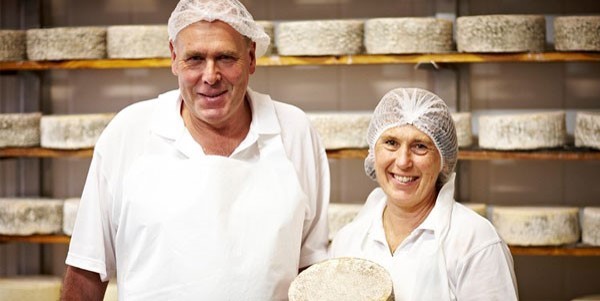Behind the Scenes with Cheese Makers Melbourne: Featuring Floridia Cheese
Behind the Scenes with Cheese Makers Melbourne: Featuring Floridia Cheese
Blog Article
Unlocking the Keys of Artisanal Cheese Making: A Step-by-Step Do It Yourself Guide
In the realm of culinary craftsmanship, artisanal cheese making stands as a testament to the delicate equilibrium in between practice and technology. As we embark on this journey to debunk the art of developing splendid cheeses, we are faced with a tapestry of abilities and secrets waiting to be deciphered.
Choosing the Right Milk
When beginning on the trip of artisanal cheese making, the selection of milk plays a critical duty in establishing the high quality and characteristics of the last product. The kind of milk chosen influences the flavor, texture, and in general account of the cheese.
When selecting milk for cheese production, it is essential to think about the fat material. Higher fat material in milk can result in a creamier and richer cheese, while reduced fat content may lead to a drier and firmer structure. Additionally, the resource of the milk, whether from cows, goats, lamb, or buffalo, contributes distinctive flavors and characteristics to the cheese (Cheese Makers Melbourne). Each kind of milk brings its own subtleties, permitting a variety of cheese varieties to be crafted based on the selected milk. Inevitably, the option of milk is an essential decision that sets the structure for an effective artisanal cheese-making endeavor.
Culturing and Coagulating
To initiate the cheese-making procedure, the essential steps of culturing and coagulating must be meticulously implemented to transform milk into curds and whey. Culturing includes presenting advantageous bacteria to the milk, which after that starts the fermentation procedure. These microorganisms transform lactose (milk sugar) right into lactic acid, developing the acidic atmosphere necessary for coagulation. The sort of society made use of can dramatically influence the taste, appearance, and ripening of the last cheese product.

The timing and temperature level control throughout culturing and coagulation are essential aspects that influence the last result of celebrity. Proper implementation of these steps is important to guarantee the wanted structure, flavor, and uniformity of the artisanal cheese being produced.
Draining Pipes and Pressing Curds
After the milk proteins have actually coagulated and the curds have been reduced to release whey, the following important action in artisanal cheese making includes draining and pushing the curds to achieve the preferred structure and consistency of the final cheese item. Draining is the procedure of dividing the curds from the whey. This can be done by moving the curds into a cheesecloth-lined bowl-shaped sieve or mold and enabling the whey to drain pipes off naturally. The moment for draining can vary depending on the type of cheese being made and the desired wetness web content.
Pushing helps remove any type of remaining whey and compacts the curds to form a solid cheese wheel. Appropriate draining pipes and pushing are crucial actions that dramatically impact the high quality and attributes of the artisanal cheese being generated.
Aging and Flavor Methods
Carrying out careful aging and flavoring methods is essential in improving the depth and complexity of artisanal cheeses, boosting their preference accounts to splendid levels of improvement and sophistication. Aging plays an essential role in creating the distinct flavors and textures that identify artisanal cheeses. During the aging process, cheeses are saved in meticulously regulated atmospheres where elements such as moisture, temperature, and airflow are adjusted to motivate the growth of beneficial mold and mildews and germs. This regulated atmosphere allows celebrity to mature slowly, creating abundant flavors and complex scents.
Seasoning techniques likewise add significantly to the final preference of artisanal cheeses. Cheesemakers might choose to present added flavors by integrating active ingredients such as herbs, seasonings, or perhaps fruits into celebrity during the manufacturing procedure. In addition, some cheeses are washed or rubbed with different liquids, such as salt water or alcohol, to boost their textures and flavors.
Wrapping and Keeping Cheeses

Conclusion
Finally, mastering the art of artisanal cheese making involves carefully picking the best milk, adhering to accurate culturing and coagulating procedures, draining pipes and pressing curds effectively, and making use of various aging and flavor strategies. By complying with these actions diligently and with interest to information, you can create your own scrumptious and distinct cheeses in the house. Remember to wrap and keep your cheeses properly Learn More Here to ensure optimal flavor and appearance advancement. Delighted cheese making!
Each kind of milk brings its very own subtleties, enabling for a large array of cheese selections to be crafted based on the picked milk.After the milk healthy proteins have coagulated and the curds have been reduced to launch whey, the following crucial action in artisanal cheese making entails draining and pressing the curds to accomplish the desired texture and consistency of the final cheese item. The majority of cheeses must be covered in wax paper or cheese paper to permit them to breathe while safeguarding them from drying out. For cheeses that need to continue aging, such as bloomy peels or cleaned rinds, ensure they are saved in an amazing environment like a cheese cavern or a fridge established to the appropriate temperature level. By paying focus to the wrapping and storage of artisanal cheeses, cheese my company manufacturers and fanatics can protect the honesty of these delicacies and totally appreciate their intricate flavors.
Report this page